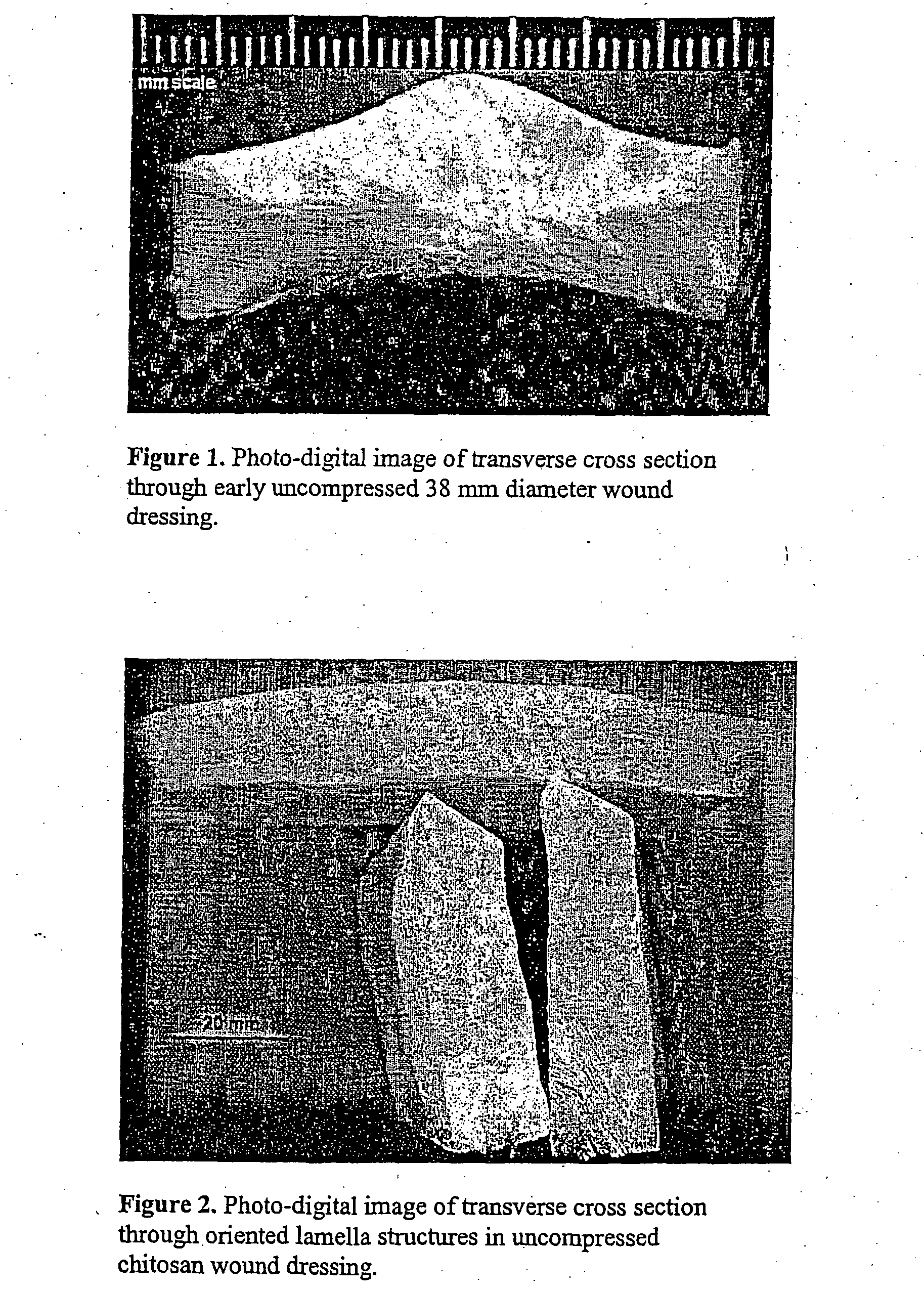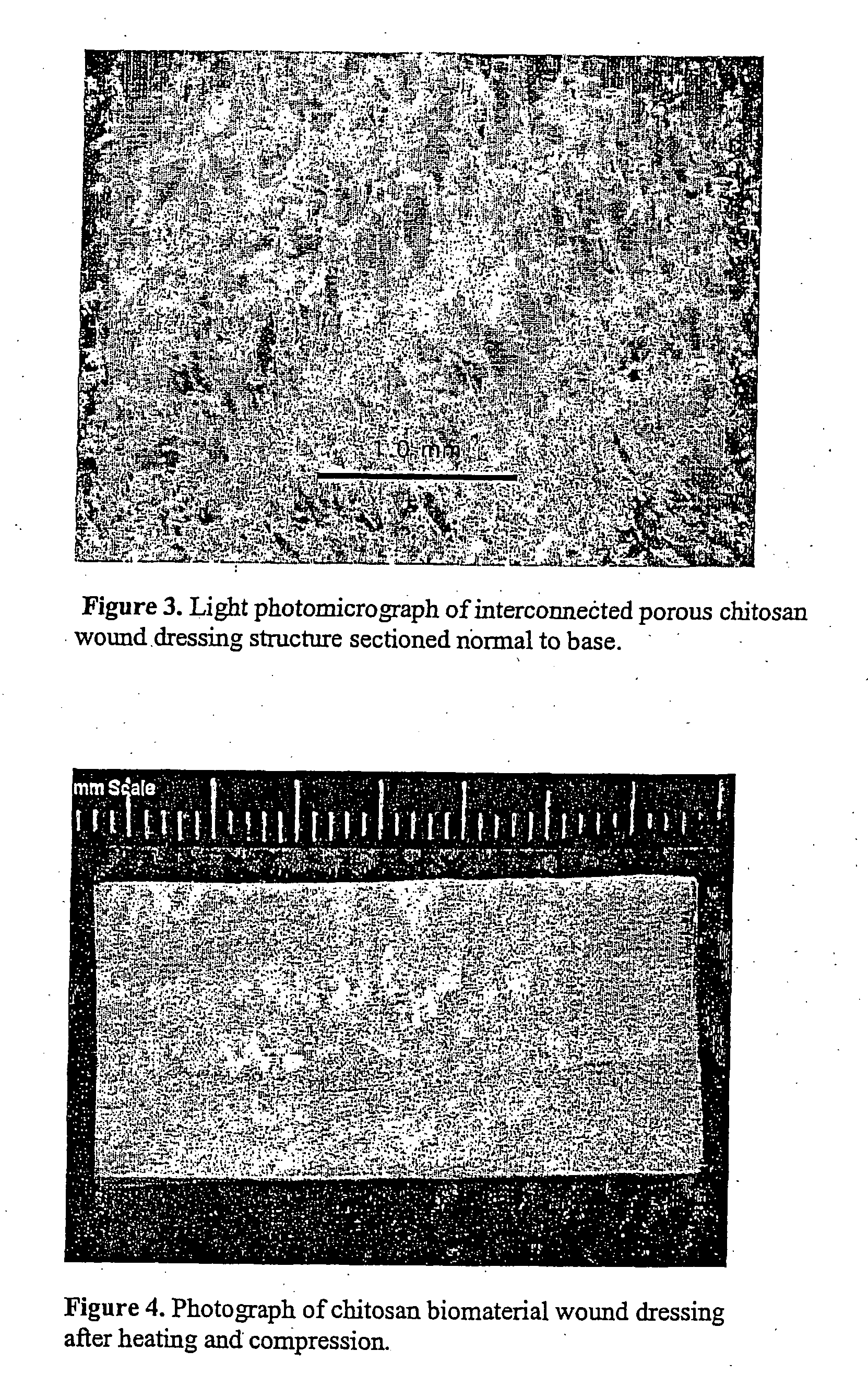Wound dressing and method for controlling severe, life-threatening bleeding
a wound dressing and life-threatening technology, applied in the field of hemorrhage control wound dressings, can solve the problem of no low-cost wound dressings suitable for controlling severe life-threatening bleeding
- Summary
- Abstract
- Description
- Claims
- Application Information
AI Technical Summary
Benefits of technology
Problems solved by technology
Method used
Image
Examples
example 1
Hemorrhage Control Testing
[0146] Table 1 provides a list of the main chitosan materials acquired for hemorrhage control testing. With the exception of the Gelfoam™+thrombin, and Surgicel™ controls for swine spleen experiments and the Johnson and Johnson 4″×4″ gauze control for use in swine aortic perforations, the dressing materials described here were all chitosan-based.
TABLE 1CarbomerGenisSourceProtosan (Norway)(USA)Primex (Norway)(Iceland)Sample NameG213G113CL213CL1139012-75-4ChitoclearBatch Number511-583-005-370-01607-783-02310-490-01VA-UY992BN 381TM 752TM 751SO11115-101Bio- SourceCrab & / orCrab & / orCrab & / orCrab & / orShrimpShrimpShrimpShrimpShrimpShrimpShrimpShrimpShrimpAppearanceFine whiteFine whiteFine whiteFine whiteYellowedFine off-Fine off-Fine off-Off-whitepowderpowderpowderpowderpowder +whitewhitewhiteflakespeckspowderpowderpowderViscosity cps1081213312NANA1091561216(1% soln)% Dry Matter 93.090.3 90.893.9NANA 97.7 97.6 93% Protein 0.2 0.2 0.1 0.1NANA % Deacetylation 8...
example 2
Preparation and Evaluation of Wound Dressing
[0150] Hemostatic wound dressings were prepared as follows: [0151] a) Dry chitosan powder or flake with degree of deactylation above 85%, less than 26 ppm metallic component and greater than 90% dry solids content was made in a 2% aqueous solution (w / w) with about 2 or 1% acetic acid (w / w) at 40° C. [0152] b) The solution of chitosan from a) above was degassed under reduced pressure at up to about 500 mTorr under agitation for at least 5 minutes and poured into a mold to a depth of 1.7 cm. Certain low-density, foam structures exhibited problems due to their ready dissolution in a bleeding field. These problems were generally avoided by thorough degassing of the solution. [0153] c) The mould containing the degassed chitosan solution was frozen by cooling from room temperature to −45° C. A linear cooling ramp was used over a 90 minute period, and the temperature was maintained at −45° C. for at least another hour. [0154] d) The frozen chito...
example 3
Hepatic Hemorrhage Control in Swine Liver Model
[0196] The US Army Science and Technology Objective (STO) A, Hemorrhage Control, was established in 2000 to advance the need for hemorrhage control on the battlefield. The general strategic objective of the STO can be summarized as the development of products and methods that will reduce the number of deaths due to hemorrhage in battlefield casualties. The requirements for hemorrhage control products and methods were stated thus:
[0197] They must be practicable for use by one or more of the following: self (wounded combatant), buddy (fellow non-medical soldier who aids the wounded soldier), combat lifesaver, combat medic, physician assistant, and battalion surgeon. They must be practicable for use in far forward field conditions including rugged terrain, limited visibility, and environmental extremes. Products and methods must not require external electrical sources. All devices must be man-portable and durable. It is expected that pro...
PUM
| Property | Measurement | Unit |
|---|---|---|
| density | aaaaa | aaaaa |
| pore diameters | aaaaa | aaaaa |
| pore diameters | aaaaa | aaaaa |
Abstract
Description
Claims
Application Information
 Login to View More
Login to View More - R&D
- Intellectual Property
- Life Sciences
- Materials
- Tech Scout
- Unparalleled Data Quality
- Higher Quality Content
- 60% Fewer Hallucinations
Browse by: Latest US Patents, China's latest patents, Technical Efficacy Thesaurus, Application Domain, Technology Topic, Popular Technical Reports.
© 2025 PatSnap. All rights reserved.Legal|Privacy policy|Modern Slavery Act Transparency Statement|Sitemap|About US| Contact US: help@patsnap.com



